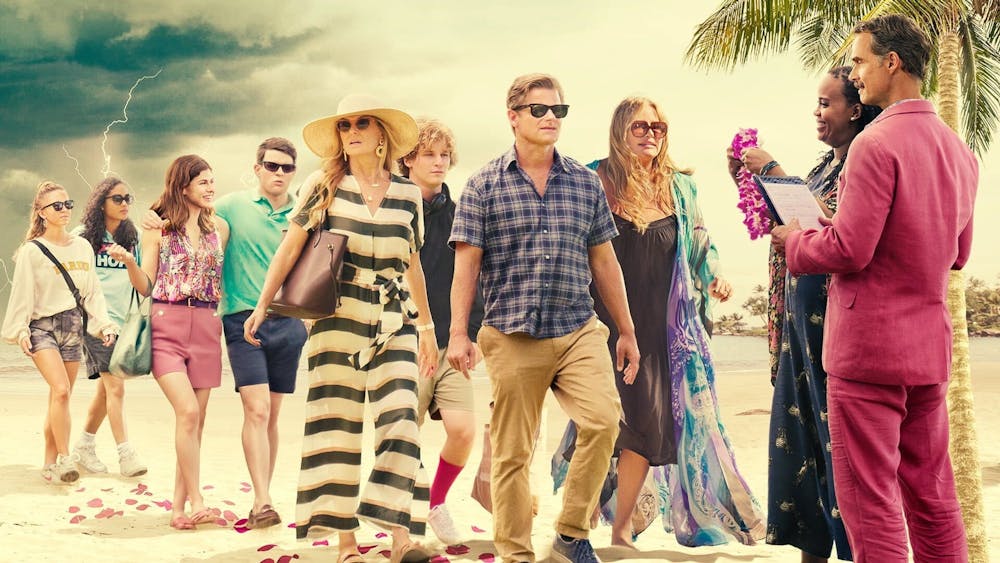SPOILER ALERT
A tropical paradise vacation for some, a dreamy honeymoon and place of catharsis for others, and for one very special guest, a grown man shitting in a suitcase. What more could you ask from a resort or TV show?
The White Lotus, Mike White’s satirical take on the Upstairs/Downstairs plot, premiered on HBO Max on July 11. Featuring a star-studded cast including Connie Britton, Jennifer Coolidge and Sydney Sweeney, the show follows the lives of three groups of wealthy, white vacationers as they interact with the partially-Native-Hawaiian staff at the White Lotus resort in Hawaii.
Every character navigates their own twisted, dark plotline, all of which center around the themes of white privilege and the influence of wealth. The plot examines the monstrousness of affluence when set against the backdrop of exploited workers and stolen land. The hotel manager, Armond, played by Murray Bartlett, is shown telling his staff that they must efface themselves at all times, fading into the background for the benefit and relaxation of the ultra-wealthy.
The satire on top of a satire unfolds as a murder occurs, marriages are tested and each character wallows in self-pity, making it almost unbearable to watch, if not for the grounding of the more down-to-earth and sane resort staff.
The show follows themes of past years’ most popular dramas, such as Big Little Lies and The Undoing, as wealth, vulgarity, and murder intertwine. But White Lotus seems to take it one step further, creating a whirlwind of white savior tropes, Hitchcock-like suspense and enough drugs and sex to satisfy Ozzy Osbourne.
The inequities between guests and staff, as well as the casual cruelties inflicted upon them, accumulate episode by episode. What it becomes is an unveiling of the power structures that rule our everyday lives, but often remain hidden.
Not only does it examine the disparity in wealth, but also the power imbalances of race and gender. To heighten the drama of it all, the score is Hitchcock-like take on island music, composed by Cristobal Tapia de Veer, blasting through the screen when characters are seemingly in danger.
The White Lotus navigates white privilege and classism beautifully, but its critiques fall short, negated by the irony of the show’s existence. White’s attempt at an Upstairs/Downstairs drama becomes more of a Mostly-Upstairs-But-Maybe-Some-Downstairs-Here-And-There drama, as the focus of the show and the most interesting plotlines are given to the wealthy, white vacationers. The Native Hawaiian staff are left to clean up after them, sharing a fraction of their screen time.
Though White tries to challenge white privilege in his cheeky plot, the perspectives of his white characters are privileged, and the rest remain one-dimensional and forgotten.
In fact, there are only four non-white characters out of the 15 named characters. Jolene Purdy who plays Lani, a trainee at the resort, is featured in only one episode before she mysteriously disappears from the fictional universe.
The show features two black characters: Belinda, played by Natasha Rothwell, and Paula, played by Brittany O’Grady. Belinda’s story can be summed up in a sentence: Another Black woman is left disappointed by empty promises from a white woman. Paula, privileged in the fact that she exists in the “Upstairs” (being brought along by the Mossbacher’s daughter), is able to more fully develop her character in forming a relationship with Kai, another staff member played by Native Hawaiian Kekoa Scott Kekumano.
Paula learns from Kai about the exploitation of the Native Hawaiians, and encourages him to steal from the Mossbachers, whose wealth she sees as excessive. However, when Kai does this, he’s quickly caught and arrested. Though a poignant and realistic ending for Kai, the depth of his character is not explored any further, and no other Native Hawaiian actors have named characters.
White’s critiques on white privilege and white saviorism might have been effective had they not been overshadowed by the actual white privilege and saviorism plaguing the creation of the show.
Though the show preaches messages about the evils of colonialism, the mostly-white cast and crew shot in Hawaii, despite the dangers of traveling to Hawaii during a pandemic (dangers so severe that Hawaiians are now asking tourists to stop traveling to Hawaii during the pandemic due to a surge of COVID-19 cases).
The irony of the show goes further with its instantly recognizable score by composer de Veer. The score takes inspiration from a watered-down, pop-culture, stereotype of tribal music. What de Veer describes as “Hawaiian Hitchcock” is his interpretation of what tribal Hawaiian music might reflect: disorder and savagery (much of the score being composed with the use of human bones, with intermittent moans and wails). The misconception that “tribal” equals “savage” is the same generalization that led to colonization itself.
There is only so much that rich white people can critique about rich white people before it starts to sound ingenuine. In the case of The White Lotus, it is. Suspended disbelief is one thing — but watching an almost entirely white cast create a satire about white saviorism and colonialism while filming at a Four Seasons Resort in Hawaii is another.
In the end, The White Lotus is just as performative as the stereotypical Gen-Z activist played by Sydney Sweeney that it mocks. Maybe the show ought to take a lesson from itself.
The White Lotus has been renewed for another season, though with a different plotline and set of characters. Maybe this time the marginalized characters it attempts to appeal to will be used as more than just props for the white actors who are, essentially, playing themselves.
Or, maybe HBO Max needs to think of another way to empower Hawaiian voices that doesn’t involve a show created, written and directed by a white man.
Sadie Wuertz is the Sports Editor at The Beacon. She can be reached at wuertz22@up.edu.
Mia Werner is the Opinions Editor at The Beacon. She can be reached at wernermi22@up.edu.








